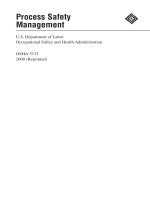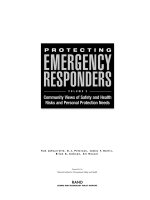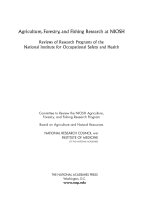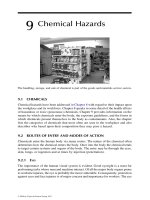Dessler ch 16 employee safety and health
Bạn đang xem bản rút gọn của tài liệu. Xem và tải ngay bản đầy đủ của tài liệu tại đây (690.1 KB, 48 trang )
Gary Dessler
tenth edition
Part 5 Employee Relations
Chapter 16
Employee Safety and Health
© 2005 Prentice Hall Inc.
All rights reserved.
PowerPoint Presentation by Charlie Cook
The University of West Alabama
After studying this chapter,
you should be able to:
1.
Explain the basic facts about OSHA.
2.
Explain the supervisor’s role in safety.
3.
Minimize unsafe acts by employees.
4.
Explain how to deal with important occupational
health problems.
© 2005 Prentice Hall Inc. All rights reserved.
16–2
16–2
Occupational Safety Law
Occupational Safety and Health Act
– The law passed by Congress in 1970 “to assure so
far as possible every working man and woman in
the nation safe and healthful working conditions
and to preserve our human resources.”
Occupational Safety and Health
Administration (OSHA)
– The agency created within the Department of
Labor to set safety and health standards for
almost all workers in the United States.
© 2005 Prentice Hall Inc. All rights reserved.
16–3
OSHA Standards and Record Keeping
OSHA standards
– General industry standards, maritime standards,
construction standards, other regulations and
procedures, and a field operations manual.
Record keeping
– Employers with 11 or more employees must
maintain records of, and report, occupational
injuries and occupational illnesses.
– Occupational illness
• Any abnormal condition or disorder caused by exposure
to environmental factors associated with employment.
© 2005 Prentice Hall Inc. All rights reserved.
16–4
OSHA Standards Examples
Guardrails not less than 2″ × 4″ or the equivalent
and not less than 36″ or more than 42″ high, with a
midrail, when required, of a 1″ × 4″ lumber or
equivalent, and toeboards, shall be installed at all
open sides on all scaffolds more than 10 feet above
the ground or floor.
Toeboards shall be a minimum of 4″ in height.
Wire mesh shall be installed in accordance with
paragraph [a] (17) of this section.
© 2005 Prentice Hall Inc.
All rights reserved.
Source: General Industry Standards and Interpretations, U.S. Department of Labor,
OSHA (Volume 1: Revised 1989, Section 1910.28(b) (15)), p. 67.
Figure 16–1
16–5
What Accidents Must
Be Reported Under
the Occupational
Safety and Health
Act (OSHA)
© 2005 Prentice Hall Inc.
All rights reserved.
Figure 16–2
16–
6
Form Used to
Record
Occupational
Injuries and
Illnesses
© 2005 Prentice Hall Inc.
All rights reserved.
Source: U.S. Department of Labor.
Figure 16–3
16–7
OSHA Inspection Priorities
Inspections of imminent danger situations
Inspections of catastrophes, fatalities, and
accidents that have already occurred
Inspections related to valid employee
complaints of alleged violation standards.
Periodic, special-emphasis inspections aimed
at high-hazard industries, occupations, or
substances.
Random inspections and reinspections.
© 2005 Prentice Hall Inc. All rights reserved.
16–8
Conduct of OSHA Inspections
OSHA officer arrives at the workplace.
He or she displays official credentials and asks to meet an
employer representative.
The officer explains the visit’s purpose, the scope of the
inspection, and the standards that apply.
An authorized employee representative accompanies the officer
during the inspection.
The inspector can also stop and question workers (in private, if
necessary) about safety and health conditions.
The inspector holds a closing conference with the employer’s
representative to discuss apparent violations which may result in
a citation and penalty.
At this point, the employer can produce records to show
compliance efforts.
© 2005 Prentice Hall Inc. All rights reserved.
16–9
Citations and Penalties
Citation
– A summons informing employers and employees
of the regulations and standards that have been
violated in the workplace.
Penalties
– Are calculated based on the gravity of the
violation and usually take into consideration
factors like the size of the business, the firm’s
compliance history, and the employer’s good faith.
© 2005 Prentice Hall Inc. All rights reserved.
16–10
Most Frequently Cited OSHA Standards:
The Top 10 for 2002
Standard
Subject
1926.451
Scaffolding, General Requirements
8,423
1910.120
Hazard Communication
6,951
1926.501
Fall Protection
5,461
1910.134
Respiratory Protection
4,250
1910.147
Lockout/Tagout
3,973
1910.305
Electrical, Wiring Methods
3,202
1910.212
Machines, General Requirements
2,878
1910.178
Powered Industrial Trucks
2,574
1910.303
Electrical Systems Design
2,291
1910.219
Mechanical Power-Transmission Apparatus
2,088
Note:
No. of Citations
Data shown reflect Federal OSHA citations issued during the period October 2001 through
September 2002. Penalty amounts represent the assessment for the specified citation as of
November 2002, taking into consideration all settlement adjustments.
© 2005 Prentice Hall Inc.
All rights reserved.
Source: James Nash, “Enforcement: Scaffolding Is Still No. 1,” Occupational Hazards Jan. 2003, p. 14.
16–
11
Figure 16–4
Inspection Guidelines
Initial Contact
– Refer the inspector to the company’s OSHA coordinator.
– Check the inspector’s credentials.
– Ask the inspector why he or she is inspecting the
workplace: Complaint? Regular scheduled visit? Fatality or
accident follow-up? Imminent danger?
– If the inspection stems from a complaint, you are entitled to
know whether the person is a current employee, though not
the person’s name.
– Notify your counsel, who should review all requests for
documents and information, as well as documents and
information you provide.
© 2005 Prentice Hall Inc. All rights reserved.
16–12
Inspection Guidelines (cont’d)
Opening Conference
– Establish the focus and scope of the planned inspection.
– Discuss the procedures for protecting trade secret areas.
– Show the inspector you have safety programs in place. He
or she may not go to the work floor if paperwork is
complete and up to date.
© 2005 Prentice Hall Inc. All rights reserved.
16–13
Inspection Guidelines (cont’d)
Walk-around inspection
– Accompany the inspector and take detailed notes.
– If the inspector takes a photo or video, you should, too.
– Ask for duplicates of all physical samples and copies of all
test results.
– Be helpful and cooperative, but don’t volunteer information.
– To the extent possible, immediately correct any violation the
inspector identifies.
© 2005 Prentice Hall Inc. All rights reserved.
16–14
Responsibilities and Rights of Employers
Employer responsibilities
– To meet the duty to provide “a workplace free from
recognized hazards.”
– To be familiar with mandatory OSHA standards.
– To examine workplace conditions to make sure they
conform to applicable standards.
Employer rights
– To seek advice and off-site consultation from OSHA.
– To request and receive proper identification of the OSHA
compliance officer before inspection.
– To be advised by the compliance officer of the reason for an
inspection.
© 2005 Prentice Hall Inc. All rights reserved.
16–15
Responsibilities and Rights of Employees
Employee responsibilities
– To comply with all applicable OSHA standards
– To follow all employer safety and health rules and
regulations.
– To report hazardous conditions to the supervisor.
Employee rights
– The right to demand safety and health on the job without
fear of punishment.
OSHA cannot cite employees for violations of their
responsibilities.
© 2005 Prentice Hall Inc. All rights reserved.
16–16
Dealing with Employee Resistance
The employer is liable for any penalties that
result from employees’ noncompliance with
OSHA standards.
– Ways to gain compliance
• Bargain with the union for the right to discharge or
discipline an employee who disobeys an OSHA
standard.
• Establish a formal employer-employee arbitration
process for resolving OSHA-related disputes.
• Use positive reinforcement and training for gaining
employee compliance.
© 2005 Prentice Hall Inc. All rights reserved.
16–17
OSHA
Safety
Poster
© 2005 Prentice Hall Inc.
All rights reserved.
16–
18
Figure 16–5
10 Ways To Get into Trouble with OSHA
Ignore or retaliate against employees who raise safety issues.
Antagonize or lie to OSHA during an inspection.
Keep inaccurate OSHA logs and have disorganized safety files.
Do not correct hazards OSHA has cited you for and ignore
commonly cited hazards.
Fail to control the flow of information during and after an
inspection.
Do not conduct a safety audit, or identify a serious hazard and
do nothing about it.
Do not use appropriate engineering controls.
Do not take a systemic approach toward safety.
Do not enforce safety rules.
Ignore industrial hygiene issues.
© 2005 Prentice Hall Inc. All rights reserved.
16–19
What Causes Accidents?
Unsafe conditions
– Improperly guarded equipment
– Defective equipment
– Hazardous procedures in, on, or around machines
or equipment
– Unsafe storage—congestion, overloading
– Improper illumination—glare, insufficient light
– Improper ventilation—insufficient air change,
impure air source
Unsafe acts
© 2005 Prentice Hall Inc. All rights reserved.
16–20
Checklist of Mechanical or Physical
Accident-Causing Conditions
© 2005 Prentice Hall Inc.
All rights reserved.
Source: Courtesy of the American Insurance Association. From “A Safety Committee Man’s Guide,” p. 1–64.
16–
21
Figure 16–6
Safety
Checklist
© 2005 Prentice Hall Inc.
All rights reserved.
16–
22
Figure 16–7
How to Prevent Accidents
Remedy unsafe conditions
Emphasize safety
Select safety-minded employees
Provide safety training
Use posters, incentive programs, and positive
reinforcement to motivate employees
Use behavior-based safety
Use employee participation
Conduct safety and health audits and inspections
© 2005 Prentice Hall Inc.
All rights reserved.
16–
23
Cut-Resistant Gloves Ad
© 2005 Prentice Hall Inc.
All rights reserved.
16–
24
Figure 16–8
Employee Safety Responsibilities Checklist
© 2005 Prentice Hall Inc.
All rights reserved.
Source: Reprinted with permission of the publisher,
HRNext.com, Copyright HRNext.com, 2003.
16–
25
Figure 16–9









